University Art Exhibition Review: French Moderns, 1850-1950, ARTH 227
VerifiedAdded on 2023/01/13
|7
|1673
|64
Report
AI Summary
This report provides a review of the 'French Moderns: Monet to Matisse, 1850-1950' exhibition organized by the Brooklyn Museum and the Vancouver Art Gallery. The exhibition aimed to showcase the evolution of art during this period, featuring paintings and sculptures by prominent artists. The review analyzes the exhibition's context, including its scale and purpose, and discusses the works of Henri Matisse (focusing on 'Flowers') and Jacque Villon (focusing on 'The Philosopher'). It highlights the use of Fauvism and Cubism styles, the interpretive materials provided, and the overall success of the exhibition in educating students about art history and the evolution of artistic styles. The review also touches on the challenges encountered, such as the lack of detailed interpretive materials for some complex artworks, and concludes with an assessment of the exhibition's impact on the students' understanding of art.
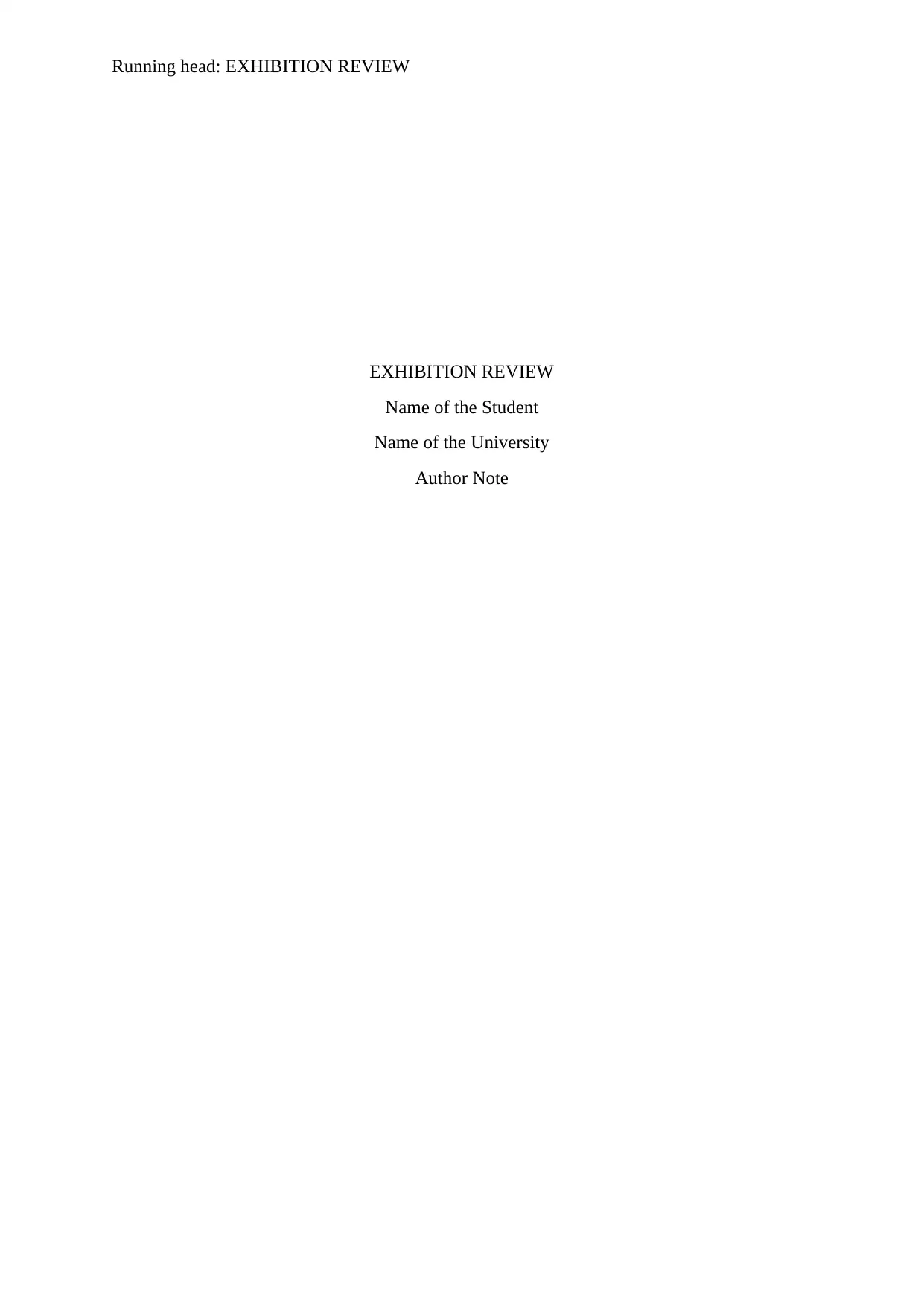
Running head: EXHIBITION REVIEW
EXHIBITION REVIEW
Name of the Student
Name of the University
Author Note
EXHIBITION REVIEW
Name of the Student
Name of the University
Author Note
Paraphrase This Document
Need a fresh take? Get an instant paraphrase of this document with our AI Paraphraser
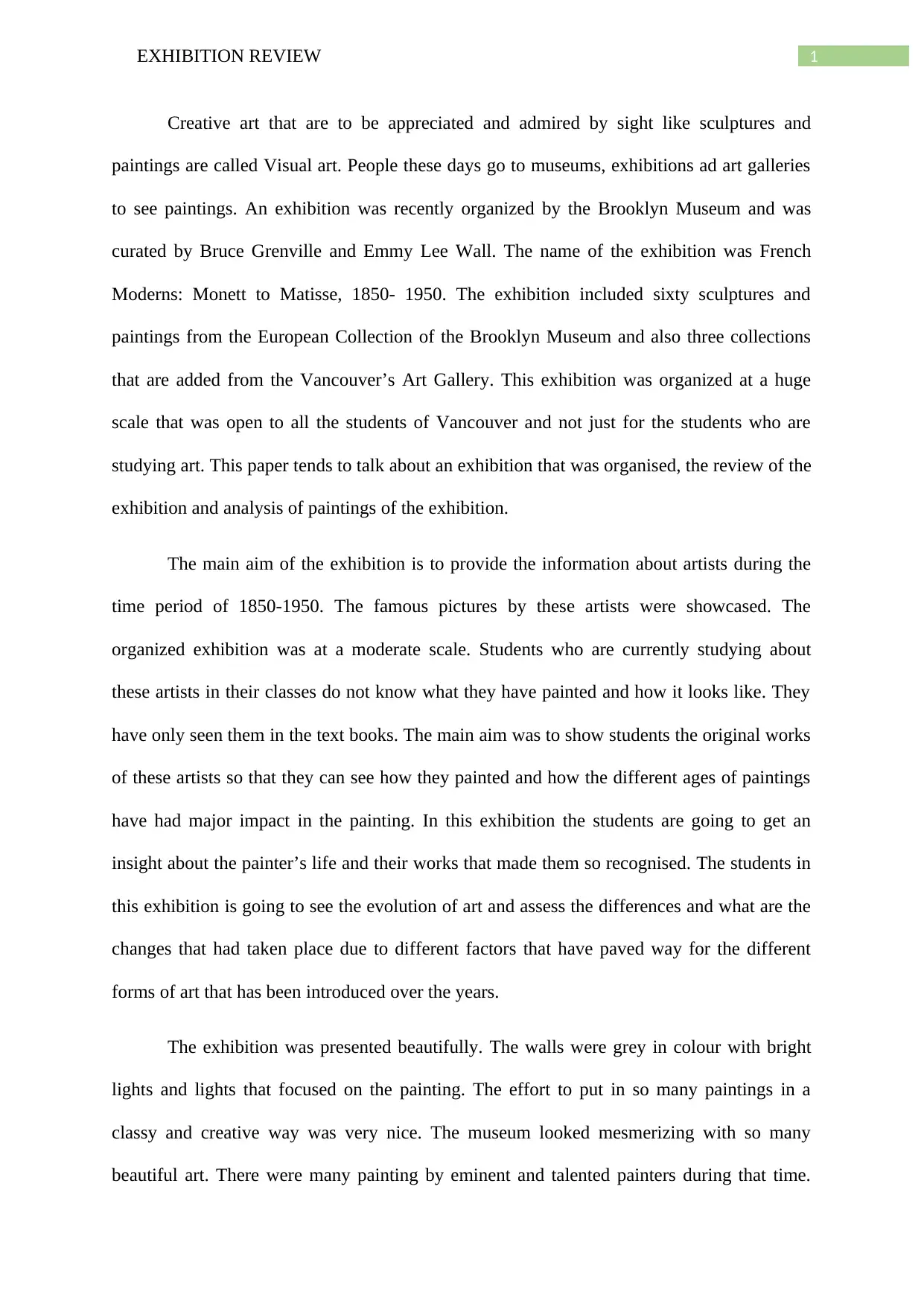
1EXHIBITION REVIEW
Creative art that are to be appreciated and admired by sight like sculptures and
paintings are called Visual art. People these days go to museums, exhibitions ad art galleries
to see paintings. An exhibition was recently organized by the Brooklyn Museum and was
curated by Bruce Grenville and Emmy Lee Wall. The name of the exhibition was French
Moderns: Monett to Matisse, 1850- 1950. The exhibition included sixty sculptures and
paintings from the European Collection of the Brooklyn Museum and also three collections
that are added from the Vancouver’s Art Gallery. This exhibition was organized at a huge
scale that was open to all the students of Vancouver and not just for the students who are
studying art. This paper tends to talk about an exhibition that was organised, the review of the
exhibition and analysis of paintings of the exhibition.
The main aim of the exhibition is to provide the information about artists during the
time period of 1850-1950. The famous pictures by these artists were showcased. The
organized exhibition was at a moderate scale. Students who are currently studying about
these artists in their classes do not know what they have painted and how it looks like. They
have only seen them in the text books. The main aim was to show students the original works
of these artists so that they can see how they painted and how the different ages of paintings
have had major impact in the painting. In this exhibition the students are going to get an
insight about the painter’s life and their works that made them so recognised. The students in
this exhibition is going to see the evolution of art and assess the differences and what are the
changes that had taken place due to different factors that have paved way for the different
forms of art that has been introduced over the years.
The exhibition was presented beautifully. The walls were grey in colour with bright
lights and lights that focused on the painting. The effort to put in so many paintings in a
classy and creative way was very nice. The museum looked mesmerizing with so many
beautiful art. There were many painting by eminent and talented painters during that time.
Creative art that are to be appreciated and admired by sight like sculptures and
paintings are called Visual art. People these days go to museums, exhibitions ad art galleries
to see paintings. An exhibition was recently organized by the Brooklyn Museum and was
curated by Bruce Grenville and Emmy Lee Wall. The name of the exhibition was French
Moderns: Monett to Matisse, 1850- 1950. The exhibition included sixty sculptures and
paintings from the European Collection of the Brooklyn Museum and also three collections
that are added from the Vancouver’s Art Gallery. This exhibition was organized at a huge
scale that was open to all the students of Vancouver and not just for the students who are
studying art. This paper tends to talk about an exhibition that was organised, the review of the
exhibition and analysis of paintings of the exhibition.
The main aim of the exhibition is to provide the information about artists during the
time period of 1850-1950. The famous pictures by these artists were showcased. The
organized exhibition was at a moderate scale. Students who are currently studying about
these artists in their classes do not know what they have painted and how it looks like. They
have only seen them in the text books. The main aim was to show students the original works
of these artists so that they can see how they painted and how the different ages of paintings
have had major impact in the painting. In this exhibition the students are going to get an
insight about the painter’s life and their works that made them so recognised. The students in
this exhibition is going to see the evolution of art and assess the differences and what are the
changes that had taken place due to different factors that have paved way for the different
forms of art that has been introduced over the years.
The exhibition was presented beautifully. The walls were grey in colour with bright
lights and lights that focused on the painting. The effort to put in so many paintings in a
classy and creative way was very nice. The museum looked mesmerizing with so many
beautiful art. There were many painting by eminent and talented painters during that time.
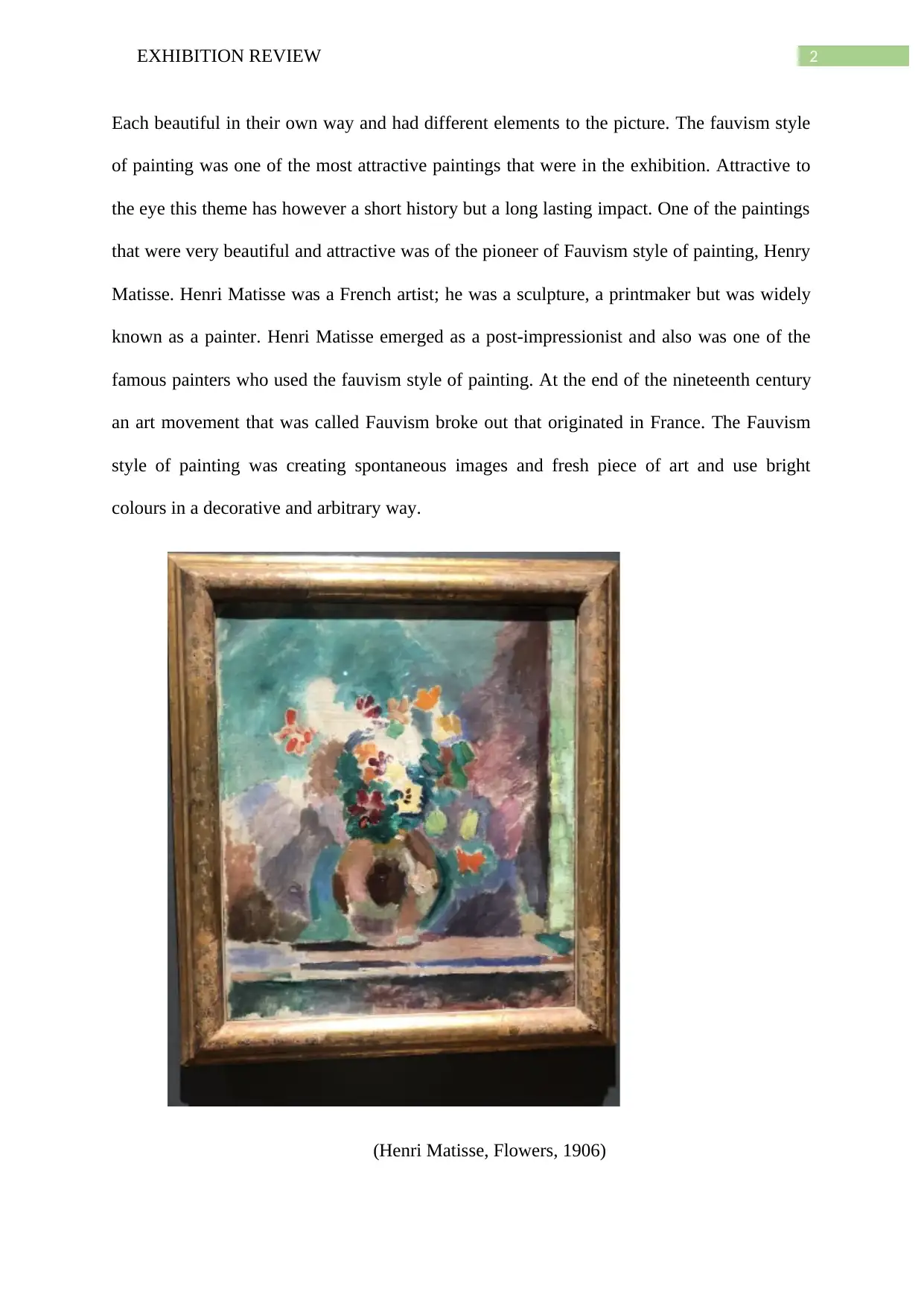
2EXHIBITION REVIEW
Each beautiful in their own way and had different elements to the picture. The fauvism style
of painting was one of the most attractive paintings that were in the exhibition. Attractive to
the eye this theme has however a short history but a long lasting impact. One of the paintings
that were very beautiful and attractive was of the pioneer of Fauvism style of painting, Henry
Matisse. Henri Matisse was a French artist; he was a sculpture, a printmaker but was widely
known as a painter. Henri Matisse emerged as a post-impressionist and also was one of the
famous painters who used the fauvism style of painting. At the end of the nineteenth century
an art movement that was called Fauvism broke out that originated in France. The Fauvism
style of painting was creating spontaneous images and fresh piece of art and use bright
colours in a decorative and arbitrary way.
(Henri Matisse, Flowers, 1906)
Each beautiful in their own way and had different elements to the picture. The fauvism style
of painting was one of the most attractive paintings that were in the exhibition. Attractive to
the eye this theme has however a short history but a long lasting impact. One of the paintings
that were very beautiful and attractive was of the pioneer of Fauvism style of painting, Henry
Matisse. Henri Matisse was a French artist; he was a sculpture, a printmaker but was widely
known as a painter. Henri Matisse emerged as a post-impressionist and also was one of the
famous painters who used the fauvism style of painting. At the end of the nineteenth century
an art movement that was called Fauvism broke out that originated in France. The Fauvism
style of painting was creating spontaneous images and fresh piece of art and use bright
colours in a decorative and arbitrary way.
(Henri Matisse, Flowers, 1906)
⊘ This is a preview!⊘
Do you want full access?
Subscribe today to unlock all pages.

Trusted by 1+ million students worldwide
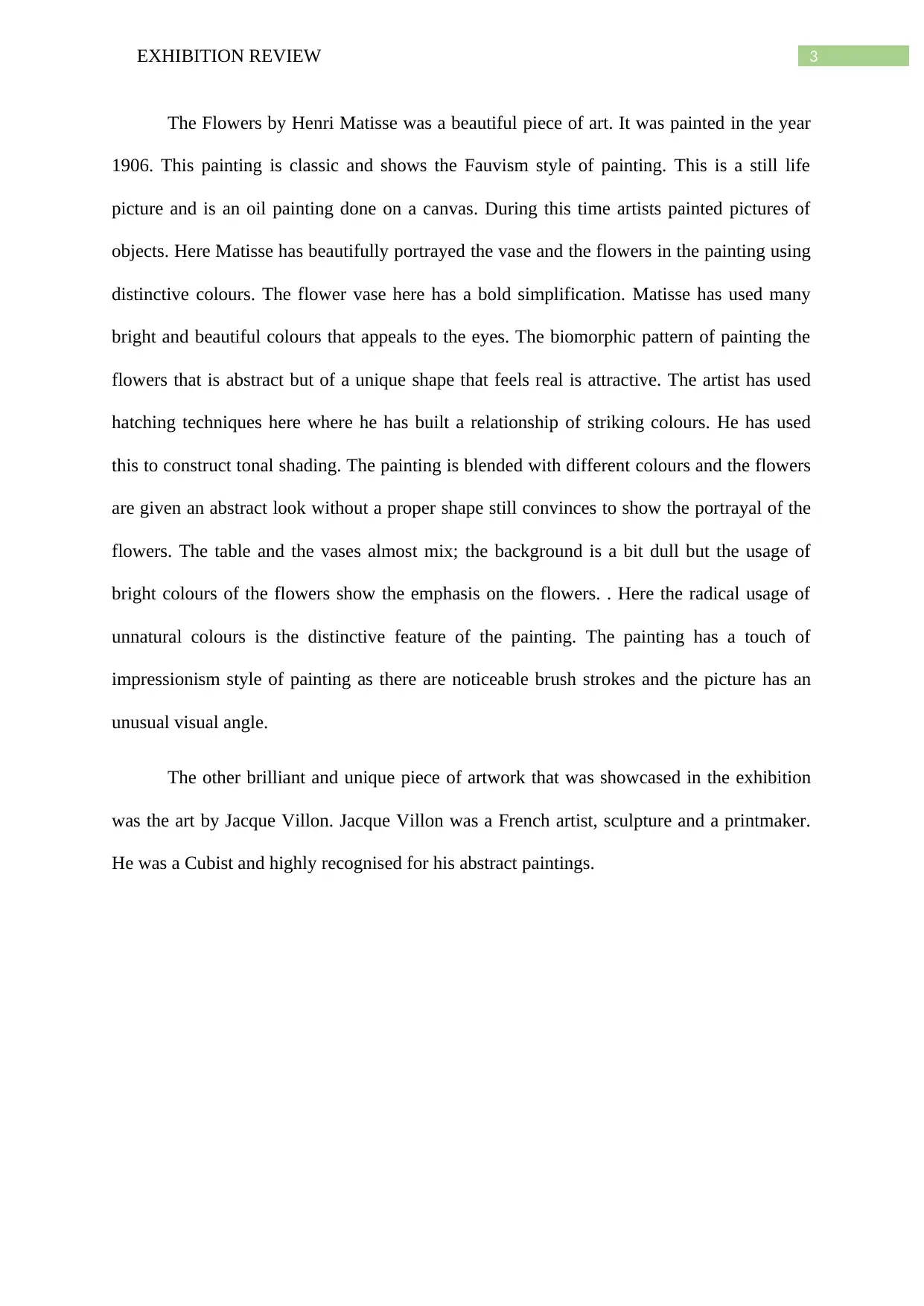
3EXHIBITION REVIEW
The Flowers by Henri Matisse was a beautiful piece of art. It was painted in the year
1906. This painting is classic and shows the Fauvism style of painting. This is a still life
picture and is an oil painting done on a canvas. During this time artists painted pictures of
objects. Here Matisse has beautifully portrayed the vase and the flowers in the painting using
distinctive colours. The flower vase here has a bold simplification. Matisse has used many
bright and beautiful colours that appeals to the eyes. The biomorphic pattern of painting the
flowers that is abstract but of a unique shape that feels real is attractive. The artist has used
hatching techniques here where he has built a relationship of striking colours. He has used
this to construct tonal shading. The painting is blended with different colours and the flowers
are given an abstract look without a proper shape still convinces to show the portrayal of the
flowers. The table and the vases almost mix; the background is a bit dull but the usage of
bright colours of the flowers show the emphasis on the flowers. . Here the radical usage of
unnatural colours is the distinctive feature of the painting. The painting has a touch of
impressionism style of painting as there are noticeable brush strokes and the picture has an
unusual visual angle.
The other brilliant and unique piece of artwork that was showcased in the exhibition
was the art by Jacque Villon. Jacque Villon was a French artist, sculpture and a printmaker.
He was a Cubist and highly recognised for his abstract paintings.
The Flowers by Henri Matisse was a beautiful piece of art. It was painted in the year
1906. This painting is classic and shows the Fauvism style of painting. This is a still life
picture and is an oil painting done on a canvas. During this time artists painted pictures of
objects. Here Matisse has beautifully portrayed the vase and the flowers in the painting using
distinctive colours. The flower vase here has a bold simplification. Matisse has used many
bright and beautiful colours that appeals to the eyes. The biomorphic pattern of painting the
flowers that is abstract but of a unique shape that feels real is attractive. The artist has used
hatching techniques here where he has built a relationship of striking colours. He has used
this to construct tonal shading. The painting is blended with different colours and the flowers
are given an abstract look without a proper shape still convinces to show the portrayal of the
flowers. The table and the vases almost mix; the background is a bit dull but the usage of
bright colours of the flowers show the emphasis on the flowers. . Here the radical usage of
unnatural colours is the distinctive feature of the painting. The painting has a touch of
impressionism style of painting as there are noticeable brush strokes and the picture has an
unusual visual angle.
The other brilliant and unique piece of artwork that was showcased in the exhibition
was the art by Jacque Villon. Jacque Villon was a French artist, sculpture and a printmaker.
He was a Cubist and highly recognised for his abstract paintings.
Paraphrase This Document
Need a fresh take? Get an instant paraphrase of this document with our AI Paraphraser
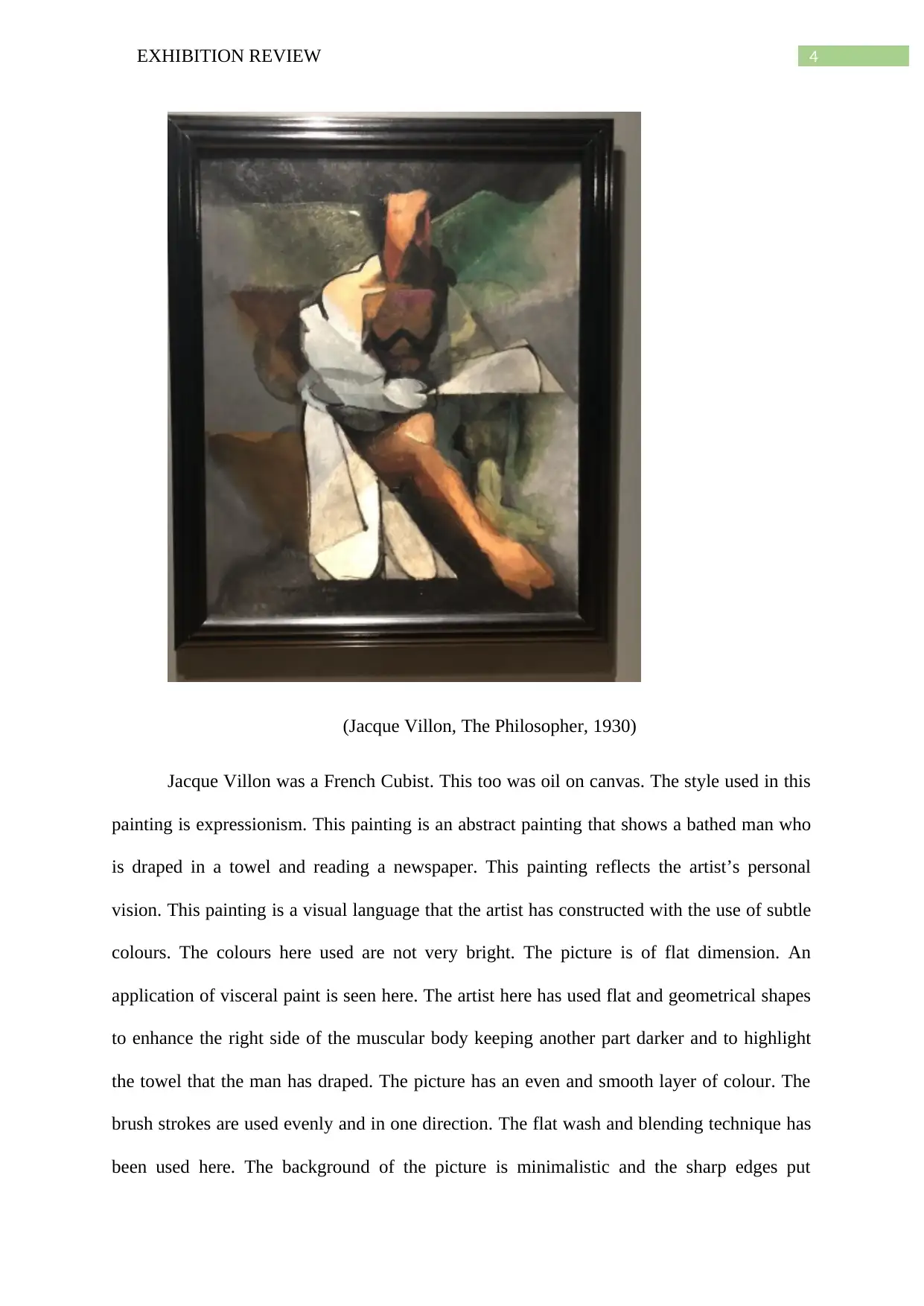
4EXHIBITION REVIEW
(Jacque Villon, The Philosopher, 1930)
Jacque Villon was a French Cubist. This too was oil on canvas. The style used in this
painting is expressionism. This painting is an abstract painting that shows a bathed man who
is draped in a towel and reading a newspaper. This painting reflects the artist’s personal
vision. This painting is a visual language that the artist has constructed with the use of subtle
colours. The colours here used are not very bright. The picture is of flat dimension. An
application of visceral paint is seen here. The artist here has used flat and geometrical shapes
to enhance the right side of the muscular body keeping another part darker and to highlight
the towel that the man has draped. The picture has an even and smooth layer of colour. The
brush strokes are used evenly and in one direction. The flat wash and blending technique has
been used here. The background of the picture is minimalistic and the sharp edges put
(Jacque Villon, The Philosopher, 1930)
Jacque Villon was a French Cubist. This too was oil on canvas. The style used in this
painting is expressionism. This painting is an abstract painting that shows a bathed man who
is draped in a towel and reading a newspaper. This painting reflects the artist’s personal
vision. This painting is a visual language that the artist has constructed with the use of subtle
colours. The colours here used are not very bright. The picture is of flat dimension. An
application of visceral paint is seen here. The artist here has used flat and geometrical shapes
to enhance the right side of the muscular body keeping another part darker and to highlight
the towel that the man has draped. The picture has an even and smooth layer of colour. The
brush strokes are used evenly and in one direction. The flat wash and blending technique has
been used here. The background of the picture is minimalistic and the sharp edges put
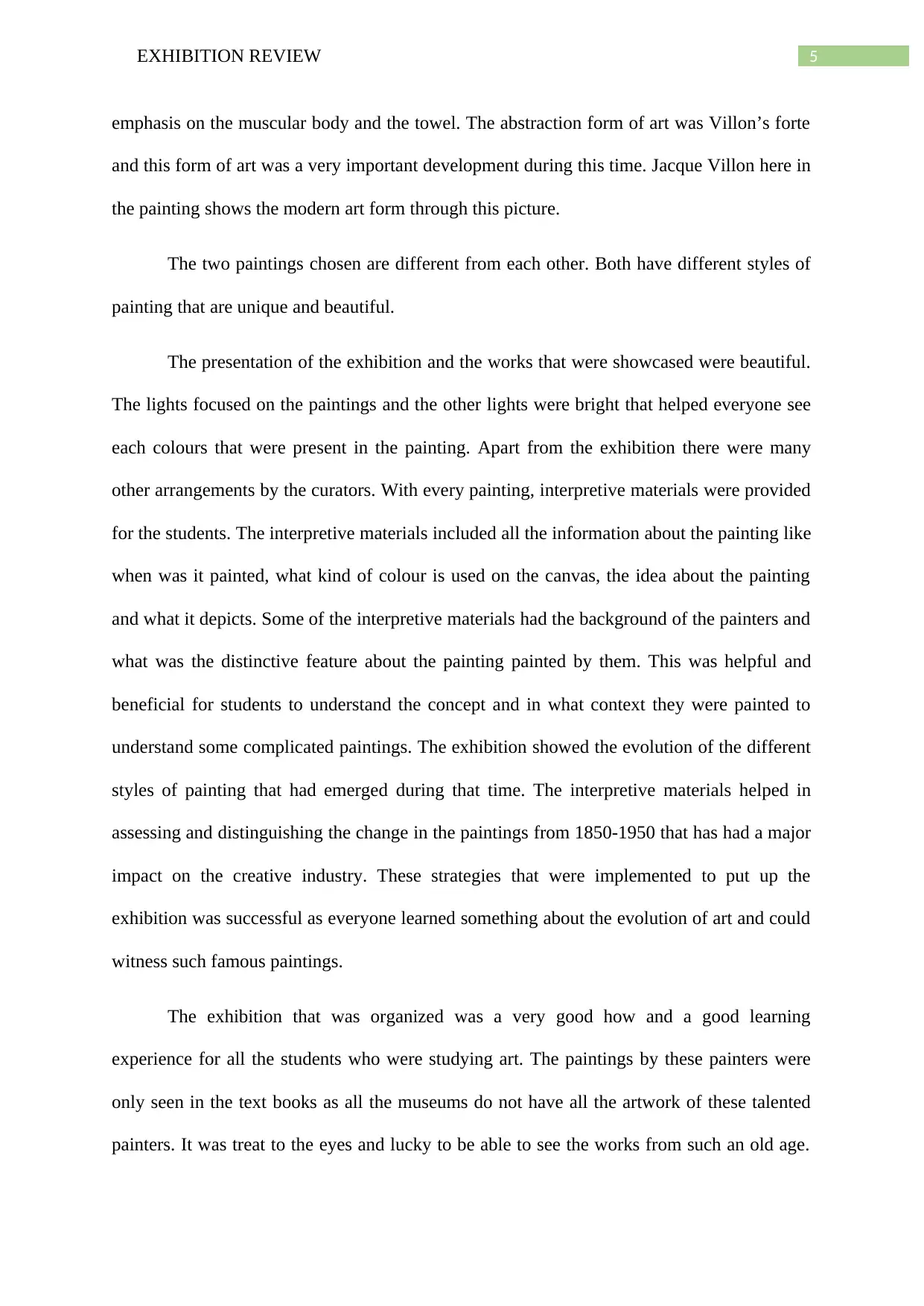
5EXHIBITION REVIEW
emphasis on the muscular body and the towel. The abstraction form of art was Villon’s forte
and this form of art was a very important development during this time. Jacque Villon here in
the painting shows the modern art form through this picture.
The two paintings chosen are different from each other. Both have different styles of
painting that are unique and beautiful.
The presentation of the exhibition and the works that were showcased were beautiful.
The lights focused on the paintings and the other lights were bright that helped everyone see
each colours that were present in the painting. Apart from the exhibition there were many
other arrangements by the curators. With every painting, interpretive materials were provided
for the students. The interpretive materials included all the information about the painting like
when was it painted, what kind of colour is used on the canvas, the idea about the painting
and what it depicts. Some of the interpretive materials had the background of the painters and
what was the distinctive feature about the painting painted by them. This was helpful and
beneficial for students to understand the concept and in what context they were painted to
understand some complicated paintings. The exhibition showed the evolution of the different
styles of painting that had emerged during that time. The interpretive materials helped in
assessing and distinguishing the change in the paintings from 1850-1950 that has had a major
impact on the creative industry. These strategies that were implemented to put up the
exhibition was successful as everyone learned something about the evolution of art and could
witness such famous paintings.
The exhibition that was organized was a very good how and a good learning
experience for all the students who were studying art. The paintings by these painters were
only seen in the text books as all the museums do not have all the artwork of these talented
painters. It was treat to the eyes and lucky to be able to see the works from such an old age.
emphasis on the muscular body and the towel. The abstraction form of art was Villon’s forte
and this form of art was a very important development during this time. Jacque Villon here in
the painting shows the modern art form through this picture.
The two paintings chosen are different from each other. Both have different styles of
painting that are unique and beautiful.
The presentation of the exhibition and the works that were showcased were beautiful.
The lights focused on the paintings and the other lights were bright that helped everyone see
each colours that were present in the painting. Apart from the exhibition there were many
other arrangements by the curators. With every painting, interpretive materials were provided
for the students. The interpretive materials included all the information about the painting like
when was it painted, what kind of colour is used on the canvas, the idea about the painting
and what it depicts. Some of the interpretive materials had the background of the painters and
what was the distinctive feature about the painting painted by them. This was helpful and
beneficial for students to understand the concept and in what context they were painted to
understand some complicated paintings. The exhibition showed the evolution of the different
styles of painting that had emerged during that time. The interpretive materials helped in
assessing and distinguishing the change in the paintings from 1850-1950 that has had a major
impact on the creative industry. These strategies that were implemented to put up the
exhibition was successful as everyone learned something about the evolution of art and could
witness such famous paintings.
The exhibition that was organized was a very good how and a good learning
experience for all the students who were studying art. The paintings by these painters were
only seen in the text books as all the museums do not have all the artwork of these talented
painters. It was treat to the eyes and lucky to be able to see the works from such an old age.
⊘ This is a preview!⊘
Do you want full access?
Subscribe today to unlock all pages.

Trusted by 1+ million students worldwide
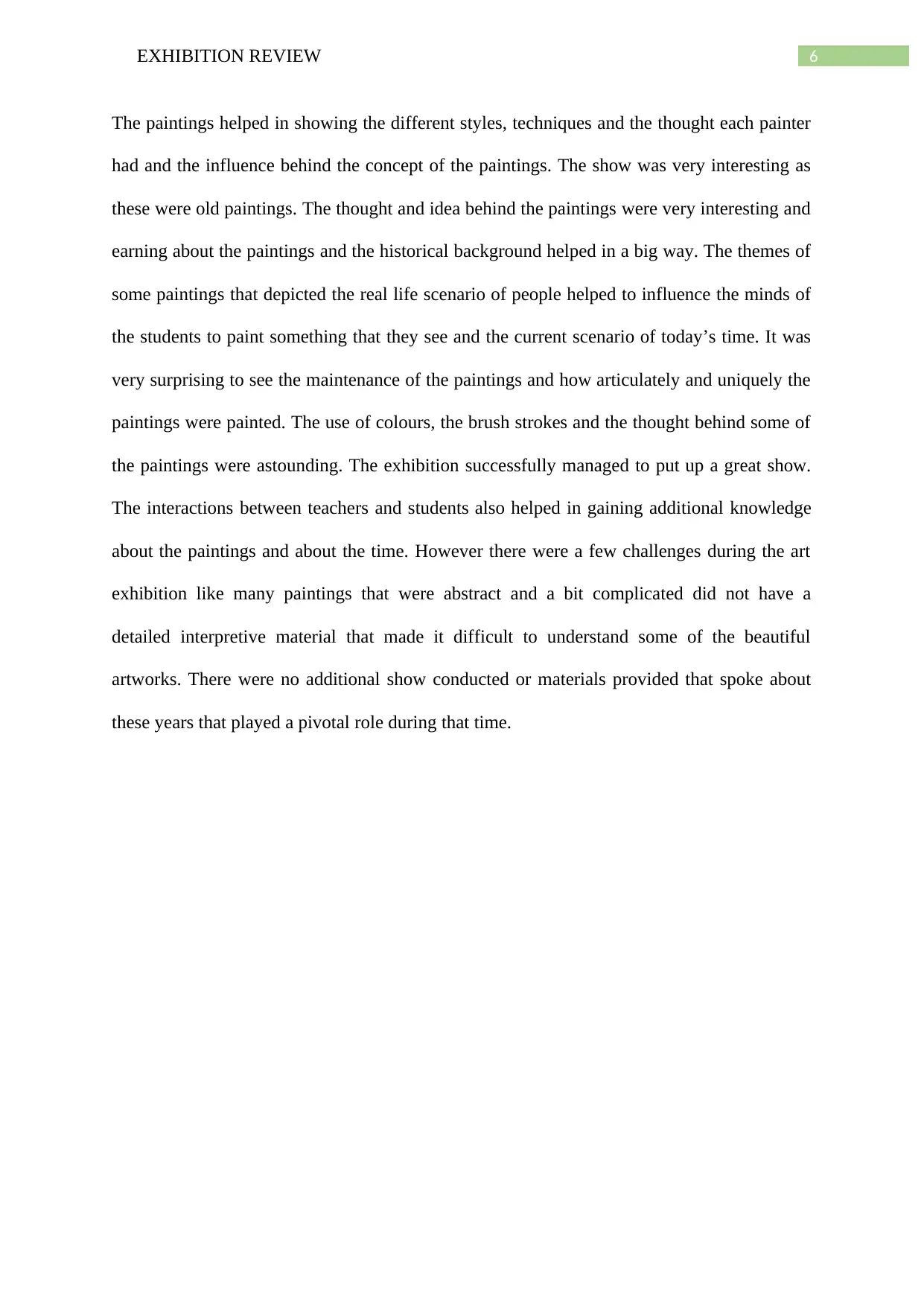
6EXHIBITION REVIEW
The paintings helped in showing the different styles, techniques and the thought each painter
had and the influence behind the concept of the paintings. The show was very interesting as
these were old paintings. The thought and idea behind the paintings were very interesting and
earning about the paintings and the historical background helped in a big way. The themes of
some paintings that depicted the real life scenario of people helped to influence the minds of
the students to paint something that they see and the current scenario of today’s time. It was
very surprising to see the maintenance of the paintings and how articulately and uniquely the
paintings were painted. The use of colours, the brush strokes and the thought behind some of
the paintings were astounding. The exhibition successfully managed to put up a great show.
The interactions between teachers and students also helped in gaining additional knowledge
about the paintings and about the time. However there were a few challenges during the art
exhibition like many paintings that were abstract and a bit complicated did not have a
detailed interpretive material that made it difficult to understand some of the beautiful
artworks. There were no additional show conducted or materials provided that spoke about
these years that played a pivotal role during that time.
The paintings helped in showing the different styles, techniques and the thought each painter
had and the influence behind the concept of the paintings. The show was very interesting as
these were old paintings. The thought and idea behind the paintings were very interesting and
earning about the paintings and the historical background helped in a big way. The themes of
some paintings that depicted the real life scenario of people helped to influence the minds of
the students to paint something that they see and the current scenario of today’s time. It was
very surprising to see the maintenance of the paintings and how articulately and uniquely the
paintings were painted. The use of colours, the brush strokes and the thought behind some of
the paintings were astounding. The exhibition successfully managed to put up a great show.
The interactions between teachers and students also helped in gaining additional knowledge
about the paintings and about the time. However there were a few challenges during the art
exhibition like many paintings that were abstract and a bit complicated did not have a
detailed interpretive material that made it difficult to understand some of the beautiful
artworks. There were no additional show conducted or materials provided that spoke about
these years that played a pivotal role during that time.
1 out of 7
Your All-in-One AI-Powered Toolkit for Academic Success.
+13062052269
info@desklib.com
Available 24*7 on WhatsApp / Email
![[object Object]](/_next/static/media/star-bottom.7253800d.svg)
Unlock your academic potential
Copyright © 2020–2025 A2Z Services. All Rights Reserved. Developed and managed by ZUCOL.


